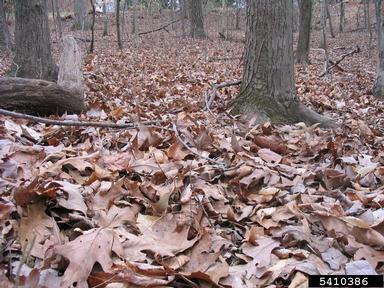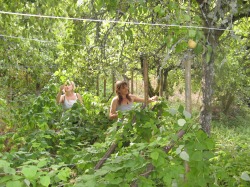 |
| What a beauty! |
I have a large-ish site in mind for it, with a rain garden / irrigation swale in place downhill of it to make sure the plants don't drown. I'm working on the soil, and soon the site will be ready for these babies.
Before these plants can go in the ground, I have to figure out exactly how to plant them, where each of them will go, and what to plant with them.
I have ordered 8 sea-buckthorns, because it is impossible to tell the gender of the individual plants before they flower. Ordering 8 means I'll definitely get at least one male plant.
Here are some of the factors I am considering:
The Wind Factor - Sea Buckthorn has two genders, and needs to be pollinated in order to bear delicious and nutritious fruit. The flowers don't attract insects, so they rely solely on the wind for pollination. That means I have to plant them in such a way that all of the plants have good air circulation. Apparently, some people use these plants as a wind break because they form impenetrable thickets.
The Thicket Factor - Not only does Sea Buckthorn send out suckers to form dense thickets, it also has thorns. To me, that says one thing:
 |
The Root Factor - Sea Buckthorn is known to send out big roots very quickly. It's great at preventing erosion for this reason. My research indicates that the roots are very similar to those of trembling aspen, which already have a colony in my garden, part of which overlaps the area I want to plant the sea buckthorns in.
 |
| Trembling Aspen: beautiful native species with medicinal value, not to mention a great place to put my hammock. |
That means competition, and competition is something to avoid in permaculture design, opting instead for cooperation and resource sharing between species. That way, all of the species are healthy, instead of just a few.
Thinking about competition means thinking about who has the advantage. In this case, the aspen colony is already established.
But, the aspen colony is old, and many of the trees are sickly, dead, or halfway to being dead. Many of them will have to be removed in the next year or two to lessen fire danger.
The Neighbor Factor - I'm not talking about my human neighbors, who are extremely awesome and with whom I shall gladly share my sea buckthorn bounty. I'm talking about the plant neighbors.
Besides the trembling aspen colony, there are lots of native grasses and spruce near the intended sea buckthorn patch. The only potential problem I see there is that white spruce can make soil acidic, but I am putting in a buffer of other, acid tolerant plants to protect the acid-sensitive sea buckthorns, so no harm done.
 |
| Mulch! Made of leaves! Leaf mulch! |
The main consideration here for me is what I want to plant with these bad boys. Unlike the other fruiting berry bushes that I've been planting this spring, I won't be able to underplant the sea buckthorn with perennials because their intensely thick throwing habit will strangle the poor suckers out in a couple years. That means annuals only for the area immediately beneath the buckthorns, or perhaps just some nice mulch to keep soil moisture constant (and to look pretty!)
Because the sea buckthorn is pollinated by wind and not insects, I won't need to plant any pollinating insect attractors nearby to help out in the pollination process. In fact, doing so might distract the bees from berry bushes where their services would be much more helpful.
Like, for example, a beautiful sour cherry sapling that I would like to plant. This is one of my main obstacles so far in this design: where to put the cherry. It has the same soil, moisture and sun needs as the sea buckthorns - which means that it ought to go in about the same area, on the uphill side of the irrigation trench. Because the flowers are so lovely, I would also like to have a sitting area nearby or beneath it. There will also need to be lots of bee attractors nearby.
I could plant some soil improving plants in and around the sea buckthorns, but it seems that won't be necessary, either. The sea buckthorns are some of the best soil amending plants there are.
 |
| Couldn't find a picture of a sun bowl. |
The sea buckthorn patch wraps around the north side of my high production garden beds. Because of their light coloured leaves (light colours are reflective of the sun's heat), height and density, the sea buckthorns will be able to block wind into those beds, keep frost out during shoulder seasons, and keep more of the sun's heat in the 'bowl'. Some permaculturists estimate that a properly designed sun bowl can increase the ambient temperature within by up to 5 degrees celsius! Such an increase could lengthen my short growing season by a couple of weeks - which could make all the difference.
 |
| Ouch! |
I figure that accessing 3 of 4 sides of each plant will be enough, which seems to indicate a triangular planting pattern.
Update May 5th: The Hill and Mulch Factor - I just read a really awesome report by the Finnish Government about the growing of Sea Buckthorn. They did a study to figure out the best ways to grow these babies as they are considered a very important crop in that country.
They found that sea buckthorn grows much better if each plant is put on a small mound, and if they are mulched with plastic. I'm willing to give that a try! Of course, I'll likely cover the plastic because I don't like the look of it, but that's just me.
Now you can see how much thought goes in to planting just one species. It may be complex, but it sure is fun. I'm going to go out in the yard and stare for a while, to see what comes to me. Stay tuned for the next installment: Sea Buckthorn - How I planted Them... with pictures!



















